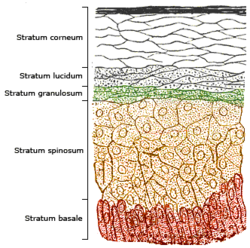
7-Dehydrocholesterol
Encyclopedia

Blood plasma
Blood plasma is the straw-colored liquid component of blood in which the blood cells in whole blood are normally suspended. It makes up about 55% of the total blood volume. It is the intravascular fluid part of extracellular fluid...
as a cholesterol
Cholesterol
Cholesterol is a complex isoprenoid. Specifically, it is a waxy steroid of fat that is produced in the liver or intestines. It is used to produce hormones and cell membranes and is transported in the blood plasma of all mammals. It is an essential structural component of mammalian cell membranes...
precursor, and is converted to vitamin D3
Cholecalciferol
Cholecalciferol is a form of vitamin D, also called vitamin D3 or calciol.It is structurally similar to steroids such as testosterone, cholesterol, and cortisol .-Forms:Vitamin D3 has several forms:...
in the skin
Skin
-Dermis:The dermis is the layer of skin beneath the epidermis that consists of connective tissue and cushions the body from stress and strain. The dermis is tightly connected to the epidermis by a basement membrane. It also harbors many Mechanoreceptors that provide the sense of touch and heat...
, therefore functioning as provitamin
Provitamin
A provitamin is a substance that may be converted within the body to a vitamin.The term "previtamin" is a synonym.For example, Provitamin B5 is a name for Panthenol, which may be converted in the body to Pantothenic Acid ....
-D3. The presence of this compound in human skin enables humans to manufacture vitamin D3
Cholecalciferol
Cholecalciferol is a form of vitamin D, also called vitamin D3 or calciol.It is structurally similar to steroids such as testosterone, cholesterol, and cortisol .-Forms:Vitamin D3 has several forms:...
from ultra-violet
Ultraviolet
Ultraviolet light is electromagnetic radiation with a wavelength shorter than that of visible light, but longer than X-rays, in the range 10 nm to 400 nm, and energies from 3 eV to 124 eV...
rays in the sun light, via an intermediate isomer
Isomer
In chemistry, isomers are compounds with the same molecular formula but different structural formulas. Isomers do not necessarily share similar properties, unless they also have the same functional groups. There are many different classes of isomers, like stereoisomers, enantiomers, geometrical...
pre-vitamin D3. It is also found in the milk
Milk
Milk is a white liquid produced by the mammary glands of mammals. It is the primary source of nutrition for young mammals before they are able to digest other types of food. Early-lactation milk contains colostrum, which carries the mother's antibodies to the baby and can reduce the risk of many...
of several mammalian species. It was discovered by Nobel-laureate organic chemist Adolf Windaus.
Location
The skin consists of two primary layers: the inner layer called the dermisDermis
The dermis is a layer of skin between the epidermis and subcutaneous tissues, and is composed of two layers, the papillary and reticular dermis...
, composed largely of connective tissue
Connective tissue
"Connective tissue" is a fibrous tissue. It is one of the four traditional classes of tissues . Connective Tissue is found throughout the body.In fact the whole framework of the skeleton and the different specialized connective tissues from the crown of the head to the toes determine the form of...
, and the outer thinner epidermis. The thickness of the epidermis ranges from 0.08mm to more than 0.6mm (0.003 to 0.024 inches). The epidermis consists of five strata; from outer to inner they are: the stratum corneum
Stratum corneum
The stratum corneum is the outermost layer of the epidermis, consisting of dead cells that lack nuclei and organelles. The purpose of the stratum corneum is to form a barrier to protect underlying tissue from infection, dehydration, chemicals and mechanical stress...
, stratum lucidum
Stratum lucidum
The stratum lucidum is a thin, clear layer of dead skin cells in the epidermis named for its translucent appearance under a microscope...
, stratum granulosum
Stratum granulosum
The stratum granulosum is a thin layer of cells in the epidermis. Keratinocytes migrating from the underlying stratum spinosum become known as granular cells in this layer...
, stratum spinosum
Stratum spinosum
The stratum spinosum is a layer of the epidermis found between the stratum granulosum and stratum basale. This layer is also referred to as the "spinous" or "prickle-cell" layer. This appearance is due to desmosomal connections of adjacent cells. Keratinization begins in the stratum spinosum....
, and stratum basale. The highest concentrations of 7-dehydrocholesterol are found in the epidermal layer of skin, specifically in the stratum basale and stratum spinosum. The production of pre-vitamin D3 is therefore greatest in these two layers, whereas production in the other layers is reduced.
Radiation
Synthesis of pre-vitamin D3 in the skin involves UVB radiation which effectively penetrates only the epidermal layers of skin. 7-Dehydrocholesterol absorbs UV light most effectively at wavelengthWavelength
In physics, the wavelength of a sinusoidal wave is the spatial period of the wave—the distance over which the wave's shape repeats.It is usually determined by considering the distance between consecutive corresponding points of the same phase, such as crests, troughs, or zero crossings, and is a...
s between 290-320nm and thus the production of vitamin D3 will only occur at those wavelengths. The two most important factors that govern the generation of pre-vitamin D3 are the quantity (intensity) and quality (appropriate wavelength) of the UVB irradiation reaching the 7-dehydrocholesterol deep in the stratum basale and stratum spinosum. Another important consideration is the quantity of 7-dehydrocholesterol present in the skin. Under normal circumstances, ample quantities of 7-dehydrocholesterol (about 25–50 mg/cm2 of skin) are available in the stratum spinosum and stratum basale of human skin to meet the body's vitamin D requirements.

